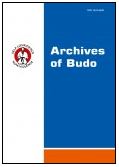2011, Volume 7, Issue 4
Ankle Joint Position Sense in Male Taekwondo Athletes after Wobble Board Training
Fatma Arslan1, Nurtekin Erkmen2, Halil Taşkın2, Ali Sallı3, Cecilia Gevat Ismet4
1Department of Physical Education and Sport, Aksaray University, Aksaray, Aksaray, Turkey
2Department of Physical Education and Sport, Selcuk University, Konya, Konya, Turkey
3Department of Physical Medicine and Rehabilitation and Department of Sports Medicine, Selcuk University, Konya, Konya, Turkey
4Faculty of Physical Education and Sport, Ovidius University of Constanta, Constanta, Romania
Author for correspondence: Nurtekin Erkmen; Department of Physical Education and Sport, Selcuk University, Konya, Konya, Turkey; email: nerkmen[at]selcuk.edu.tr
Full text
Abstract
Background and Study Aim: There is evidence of an improvement in sportive performance in the athletes after completing a wobble board training program. The purpose of this study was to increase the awareness of joint position sense by applying a six week wobble board training on ankle joint proprioception in male taekwondo athletes.
Material and Methods: Eighteen male taekwondo athletes took part in this study. Participants were randomly divided into experimental and control groups. For experimental group (n = 10) the average age, height, weight and experience time of the subjects were 19.50±2.07 years, 175.80±7.27 cm, 64.80±4.71 kg and 6.30±1.49 years, respectively. For control group (n = 8) was 19.88±2.30 years, 173.75±5.06 cm, 67.50±5.55 kg and 7.13±2.56 years, respectively. Experimental group in the wobble board was trained three times a week for the period of six weeks. To assess of ankle joint position sense (JPS), passive angle reproduction test was performed by the Biodex System 3 Dynamometer (Biodex Medical Systems, Shirley, NY, USA). Passive angle reproduction test was conducted on dominant and non-dominant ankle at 5° and 25° of plantar flexion angles. Measurements were conducted twice, before and after training.
Results: There was no significant difference in dominant ankle at 5° between JPS measurements before and after training in experimental group (t = 1.920, p = 0.087). JPS increased significantly in dominant ankle at 25° (t = 3.060, p = 0.014), non-dominant ankle at 5° (t = 2.959, p = 0.016) and 25° (t = 3.213, p = 0.011) in experimental group.
Conclusions: The wobble board training of taekwondo athletes had improved especially in non-dominant ankle JPS. Using proprioception training with wobble board may have an advantage in using dominant leg during performing of techniques concerning taekwondo sport and in decreasing the number of ankle injuries in male taekwondo athletes.
Key words: ankle, proprioception, taekwondo, training, wobble board




